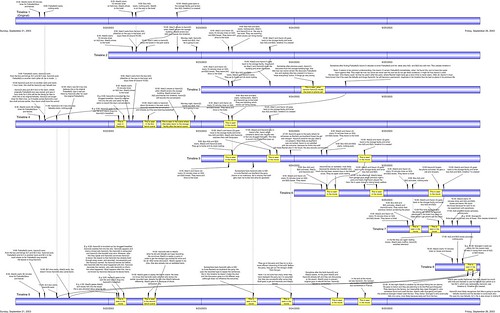Something that the almost inscrutable science-fiction film Primer does quite well is to paint enough of the contours of its science and technology to give the viewer the sense that *something is going on that should make perfectly good sense..if I was only a bit more techo-literate in the arcane minutia of quantum mechanics, time travel and so on.
Early on we see the DIY garage tinkerers/hackers/engineers working on a proof-of-concept of…something. They’re in their *garage, and that’s where weird, misunderstood, works-of-passion happen, at least in the American suburbs _ like garage bands, garage science is populated in the cultural imaginary as where real, dyed-in-the-wool innovation happens. (Much like the time-travel science/design-fiction in How To Live Safely In A Science Fictional Universe, as it turns out.)
The scene above is a favorite. We watch a device of some sort — small, exposed printed-circuit board, with a LCD numerical display that changes on a little bit. Car batteries for power; roughly hewn bread boards. Shaking assemblies; slight bits of panic and confusion. Something is happening here, and you can only watch the visual story as it unfolds to fill in the gaps. The setting makes it all seem much more possible — garage, a couple of guys discussing their work in the vernacular of…whatever they’re working on. And somehow this makes it seem honest — it’s not didactic like some techoscience-based science-fiction — or even documentaries. We’re not meant to completely understand the quantum physics here, even if it were understandable. When the story telling becomes too didactic, it loses something. It should be as complex as it would be, and possibly completely impossible for anyone to understand but the six people in the world who are working on it, like String Theory or some such.
In an interview with the director:
The film itself is intriguing for its story and how its told on the screen, but also for the production. Shane Carruth — writer, director, film score, co-star, &c. — is an engineer who wanted to tell a story and so learned how to do so by teaching himself filmmaking. Done on the cheap — $7000 according to IMDB — it won the Grand Jury Prize at Sundance in 2004 and a $20,000 prize from the Alfred P. Sloan Foundation for films dealing with science and technology. (That’s cool.)
Further in the interview, he describes an insight on the aesthetic of new ideas and innovation, which is of course much more rough-hewn then was typical for the canon of science-fiction. It’s all about the DIY finish — things bought at the local hard-goods store, or McMaster and cobbled together as best as one can with, oftentimes, low-budgets. Perhaps something like what Google’s first server looks like.
Why do I blog this? To add some additional notes to the design fiction chronicles and their attendant style conventions.
Late Edition: Nicolas Nova has pointed us to a Time Line!
Continue reading Primer: Inexplicable Ideas In Design Fiction
